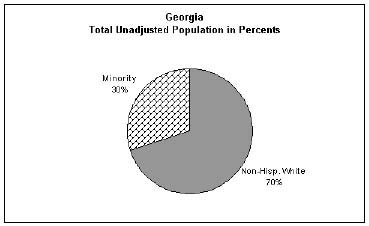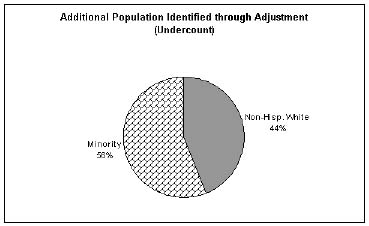State-by-State Analysis: Georgia
The
1990 undercount and its demographic composition
As
indicated in Table 1, the percentage undercount of 2.2 percent in Georgia
was higher than the national average of 1.6 percent and resulted in a net
numerical undercount of 142,425 persons, fifth highest in the nation. For
non-Hispanic whites, Table 1 indicates, the undercount percentage was 1.4
percent as compared to 4.1 percent for members of minority groups. As indicated
in Table 2 and the summary Chart below, these differentials between whites
and minorities resulted in an undercounted population with a much greater
minority group percentage than the state's total population. Minorities
comprised 30 percent of the state's uncorrected population, compared to
56 percent of the state's undercounted population. In numerical terms, the
undercount consisted of 63,044 non-Hispanic whites and 79,381 members of
minority groups. In Georgia, moreover, unlike any of the states examined
thus far, the minority population consists overwhelmingly of members of
a single minority group, in this case non-Hispanic blacks. In Georgia, 90
percent of minority group members are African-Americans, 6 percent are Hispanic,
and 5 percent are members of other minority groups.


Implications
of 1990 Census adjustment for minority voter opportunities
The
use of corrected data in Georgia for post-1990 redistricting would have
had the potential to enhance minority voter opportunities in the plan for
the State House. In Georgia, the undercount is especially concentrated in
counties in the Atlanta region, including among others DeKalb County. State
House District 65 in DeKalb County has a minority population of 36.3 percent,
primarily black. There is a sufficient undercount in DeKalb County to have
created the potential to augment substantially the minority population of
this District, given that the ideal size of a State House District is only
36,781, for corrected population data. In DeKalb County, correction uncovers
some 15,000 additional persons, including some 12,000-minority group members
(81 percent), primarily black. This additional minority population alone
equals about one-third of an ideal House district. Overall, the additional
population identified in DeKalb County is more than would have been necessary
to meet one-person, one-vote requirements, given that the use of corrected
data would increase the population of an ideal House district by only about
800 persons (from some 36,000 to 36,800).





